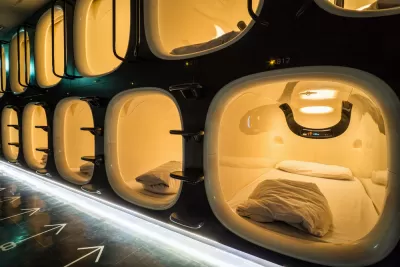Like Japan’s capsule hotels, the ‘podsharing’ housing model offers minimal, shared living space—but can it work as a long-term housing solution?

Dystopian nightmare or clever solution to the housing crisis? That’s the question many are asking about ‘sleeping pods,’ writes Robyn Griggs Lawrence in Smart Cities Dive.
“Sleeping pods were introduced in 2012 by Los Angeles-based co-housing company PodShare as a low-cost alternative for travelers and digital nomads in Los Angeles. They have evolved to become a potential solution to the severe housing shortage gripping California and the rest of the nation.” The concept originated with Japan’s popular capsule hotels and has proliferated at airports around the world. A San Francisco podsharing house charging $1,200 per bed sold out as soon as it opened in what the website 7x7 called “a depressing new low in San Francisco housing.”
As Griggs Lawrence points out, “The pods aren’t without detractors. On Reddit, one user called them ‘the dystopian future,’ and another compared them to living on a warship. Futurism staff writer Victor Tangermann called the pods ‘an extremely expensive prison cell.’”
Nevertheless, the need for affordable rental housing is greater than ever. “In October 2021, 49% of Americans said the availability of affordable housing was a major problem in their local community, according to Pew Research, and the vacancy rate for rental units has fallen from about 10% in 2010 to 5.6% at the end of 2021.”
Jill Pable, a professor and chair of the Department of Interior Architecture and Design at Florida State University, calls the podsharing model “an interesting outcome based on a whole series of new constraints and opportunities that are causing a lot of pain and anguish,” but wonders if “it can provide residents with dignity, empowerment, personal space and privacy” that are essential to human well-being.
FULL STORY: Sleeping pods: coming to a high-rent neighborhood near you?

Planetizen Federal Action Tracker
A weekly monitor of how Trump’s orders and actions are impacting planners and planning in America.

Maui's Vacation Rental Debate Turns Ugly
Verbal attacks, misinformation campaigns and fistfights plague a high-stakes debate to convert thousands of vacation rentals into long-term housing.

San Francisco Suspends Traffic Calming Amidst Record Deaths
Citing “a challenging fiscal landscape,” the city will cease the program on the heels of 42 traffic deaths, including 24 pedestrians.

Amtrak Rolls Out New Orleans to Alabama “Mardi Gras” Train
The new service will operate morning and evening departures between Mobile and New Orleans.

The Subversive Car-Free Guide to Trump's Great American Road Trip
Car-free ways to access Chicagoland’s best tourist attractions.

San Antonio and Austin are Fusing Into one Massive Megaregion
The region spanning the two central Texas cities is growing fast, posing challenges for local infrastructure and water supplies.
Urban Design for Planners 1: Software Tools
This six-course series explores essential urban design concepts using open source software and equips planners with the tools they need to participate fully in the urban design process.
Planning for Universal Design
Learn the tools for implementing Universal Design in planning regulations.
Heyer Gruel & Associates PA
JM Goldson LLC
Custer County Colorado
City of Camden Redevelopment Agency
City of Astoria
Transportation Research & Education Center (TREC) at Portland State University
Jefferson Parish Government
Camden Redevelopment Agency
City of Claremont





























